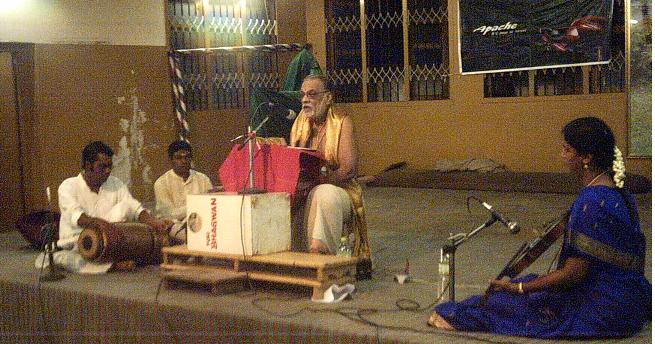| Previous Concert Reviews |
SANGEETHA RASIKA SANGAM - September 2009

|
The 124th Music Program of Sangeetha Rasika Sangam, Chennai 92 was held at Sri Varasiddhi Vinayagar Temple, Chinmayanagar (Central Chinmaya Mission Trust) on 13th September 2009.
Harikatha Sudhanamani, Madhuragana Bhushanam, Kalyanapuram Veeraraghavan, gave a lively musical Harikatha on Purandaradas accompanied by Ms B Sudha, on the violin, Ammangudi Ramanarayanan, disciple of Umayalpuram Sivaraman on the Mrudhangam. Before commencing the life story of Purandaradas, he sang a sloka in Raga Kalyani, followed by the most soul-stirring Govinda Govinda Bajan in the Raga Karnaranjani. He tried to elaborate Raga Arabi in which another sloka was melodiously presented. He then sang St Thiagaraja's Sri Rama Paadama in Amirdha Vahini. He outlined Ganamo Saharadha in Purvikalyani and indulged in Raga Mohanam by singing Kshema Kuru Gopala. As Sri Kalyanapuram Veeraraghavan began dwelling the eventful life of Purandaradas, there was an incessant flow of heart-touching Krithies composed by him. The only son of Varadappa Nayaka, a wealthy merchant, and Leelavati, he was named Srinivasa Nayaka, after the Lord of the Seven Hills, but was known as 'Cheenappa'. He received a good education in accordance with family traditions and acquired proficiency in Kannada, Sanskrit, and sacred music. At 16 he married Saraswatibai, a pious young girl. He lost his parents at 20 and inherited his father's business of gemstones. He prospered and became known as "navakoti narayana" (abundantly rich man). Sri Purandara Dasa's life is a wonderful episode in human history showing how an initially miserly was converted into a great Bhakta by the grace of Lord Vithala. The turning point in the life of Cheenappa Nayaka occurred at the instance of the Lord who in the guise of a poor brahmin begged for alms for conducting the sacred thread ceremony of his son. Cheenappa Nayaka in his customary style drove away the disguised brahmin who straight away went to his wife and repeated the drama. His wife being a very kind hearted one, gave away her diamond studded nose ring and the Brahmin went to Cheenappa Nayaka again and asked him to give some money in return for the diamond-studded ornament. Cheenappa Nayaka identifying it as his wife's ornament kept it in his iron safe and went to his wife to enquire about the nasal ring. Bewildered at the turn of events Sri Saraswathi Bai prayed to God for help. The ornament appeared in her hands to the utter surprise of Saraswathi Bai. She showed the same to Cheenappa Nayaka as if nothing has happened. Surprised at this Cheenappa realised that the Brahmin in disguise was none else than Lord Vithala. He repented for his misdeeds, begged pardon of the Lord, and renounced all his wealth to become a saint and was called "Purandaradas". The audience felt very emotional when he narrated this turning point in the life of Purandaradas who realised that his wealth was meaningless and started moving in search of Lord Panduranga! This inspired him to sing innumerable songs in Kannada, in praise of the Lord, which numbered about 4,75,000 of which about 800 survive. In his very first song composition, he laments his wasted life of indulgence. It begins with the words 'Ana lae kara' in the Shuddha Savaeri raga, set to Triputa tala. Sri Veeraraghavan further enlightened the audience that Purandaradasa systematized the method of teaching Carnatic music which is followed to the present day. He introduced the raga Mayamalavagowla as the basic scale for music instruction and fashioned series of graded lessons such as swaravalis, janta swaras, alankaras, lakshana geetas, prabandhas, ugabhogas, thattu varase, geetha, sooladis and kritis. He preferred this raga for beginners as in "Maya Malavagowla", the difference of pitch between 'Ri' and 'ga', and 'da' and 'ni' are the same and the notes sa-ri-ga-ma and pa-da-ni-sa are perfect concordant notes. This system of music is called "Karnataka Music" as he belongs to that region and the music is very pleasing to the ears. He also simplified "Thala" system and moulded it into "Pancha-Thrimsathi" Thala system and composed "Alankaras" to be sung in those Thalas. Purandara Dasa was the founder of musical pedagogy. Musicologists call him the "Sangeeta Pitamaha" (grandfather) of Carnatic music. Sri Kalyanapuram Veeraraghavan also dwelt the various events that took place in the life of Purandaradoss and how Lord Panduranga came for Purandaras' rescue whenever he was in trouble. The audience enjoyed and experienced the musical narration of Sri Kalyanapuram Veeraraghavan. The accompanying artistes gave excellent support during the entire discourse. The musical event came to a happy end after singing a Mangalam.
Sangeetha Rasika Sangam.
|